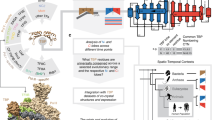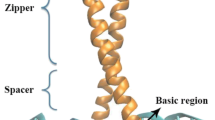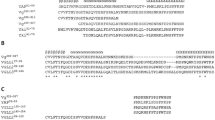Abstract
The transcriptional adaptor zinc (TAZ) fingers are a specialized class of zinc finger domains reported to exist only in eukaryotic transcriptional coactivator proteins. A putative protein within the shrimp white spot syndrome virus (WSSV) encodes for a TAZ domain, which is unique as no virus so far has been reported for the presence of this domain. Our study shows the viral TAZ domain to be similar to TAZ2 rather than TAZ1 domain of eukaryotic CREB-binding proteins and its paralog p300 proteins. Furthermore, as with eukaryotic TAZ2 domain which interacts and binds to several transcriptional factors including the p53 tumor suppressor protein, an in silico docking study of the WSSV-TAZ and the shrimp p53 transcriptional factor showed the two protein domains to be involved in a protein–protein interaction.




Similar content being viewed by others
References
Lightner DV (1996) A handbook of pathology and diagnostic procedures for diseases of penaeid shrimp. Special publication of the World Aquaculture Society, Baton Rouge
Vlak JM, Bonami JR, Flegel TW, Kou GH, Lightner DV, Lo CF, Loh PC, Walker PW (2005) Nimaviridae. In: Fauquet CM, Mayo MA, Maniloff J, Desselberger U, Ball LA (eds) Virus taxonomy. Eighth report of the international committee on taxonomy of viruses. Elsevier, Amsterdam, pp 187–192
van Hulten MC, Witteveldt J, Peters S, Kloosterboer N, Tarchini R, Fiers M (2001) The white spot syndrome virus genome sequence. Virology 286:7–22
Yang F, He J, Lin X, Li Q, Pan D, Zhang X (2001) Complete genome sequence of the shrimp white spot bacilliform virus. J Virol 75:11811–11820
He F, Kwang J (2008) Identification and characterization of a new E3 ubiquitin ligase in white spot syndrome virus involved in virus latency. Virol J 5:151–158
He F, Fenner BJ, Godwin AK, Kwang J (2006) White spot syndrome virus open reading frame 222 encodes a viral E3 ligase and mediates degradation of a host tumor suppressor via ubiquitination. J Virol 80:3884–3892
He F, Syed SM, Hameed AS, Kwang J (2009) Viral ubiquitin ligase WSSV222 is required for efficient white spot syndrome virus replication in shrimp. J Gen Virol 90:1483–1490
Jeena K, Prasad PK, Pathan MK, Babu GP (2012) Expression profiling of WSSV ORF 199 and shrimp ubiquitin conjugating enzyme in WSSV Infected Penaeus monodon. Asian Aust J Anim Sci 25:1184–1189
Wang Z, Chua HK, Gusti AA, He F, Fenner B, Manopo I, Wang H, Kwang J (2005) RING-H2 protein WSSV249 from white spot syndrome virus sequesters a shrimp ubiquitin-conjugating enzyme, PvUbc, for viral pathogenesis. J Virol 79:8764–8772
Laity JH, Lee BM, Wright PE (2001) Zinc finger proteins: new insights into structural and functional diversity. Curr Opin Struct Biol 11:39–46
Saurin AJ, Borden KLB, Boddy MN, Freemont PS (1996) Does this have a familiar RING? Trends Biochem Sci 21:208–214
Krishna SS, Majumdar I, Grishin NV (2003) Structural classification of zinc fingers: survey and summary. Nucleic Acids Res 31:532–550
Mathews JM, Sunde M (2002) Zinc fingers-folds for many occasions. IUBMB Life 54:351–355
Vo N, Goodman RH (2001) CREB-binding protein and p300 in transcription regulation. J Biol Chem 276:13505–13508
Hardy RW, Wertz GW (2000) The cys3-his1 motif of the respiratory syncytial virus M2-1 protein is essential for protein function. J Virol 74:5880–5885
Modrof J, Becker S, Mühlberger E (2003) Ebola virus transcription activator VP30 is a zinc-binding protein. J Virol 77:3334–3338
Lamberti C, Morrissey LC, Grossman SR, Androphy EJ (1990) Transcriptional activation by the papillomavirus E6 zinc finger oncoprotein. EMBO J 9:1907–1913
Berman HM, Westbrook J, Feng Z, Gilliland G, Bhat TN, Weissig H, Shindyalov IN, Bourne PE (2000) The protein data bank. Nucleic Acids Res 28:235–242
Altschul SF, Gish W, Miller W, Myers EW, Lipman DJ (1990) Basic local alignment search tool. J Mol Biol 215:403–410
Ponting CP, Schultz J, Milpetz F, Bork P (1999) SMART: identification and annotation of domains from signalling and extracellular protein sequences. Nucleic Acids Res 27:229–232
Roy A, Kucukural A, Zhang Y (2010) I-TASSER: a unified platform for automated protein structure and function prediction. Nat Protoc 5:725–738
Guex N, Peitsch MC (1997) SWISS-MODEL and the Swiss-PdbViewer: an environment for comparative protein modeling. Electrophoresis 18:2714–2723
Laskowski RA, MacArthur MW, Moss DS, Thornton JM (1993) PROCHECK—a program to check the stereochemical quality of protein structures. J Appl Crystallogr 26:283–291
Benkert P, Schwede T, Tosatto SCE (2009) QMEANclust: estimation of protein model quality by combining a composite scoring function with structural density information. BMC Struct Biol 9:35
Holm L, Rosenström P (2010) Dali server: conservation mapping in 3D. Nucleic Acids Res 38:W545–W549
Schneidman-Duhovny D, Inbar Y, Nussinov R, Wolfson HJ (2005) PatchDock and SymmDock: servers for rigid and symmetric docking. Nucleic Acids Res 33:W363–W367
DeLano WL (2002) The PyMOL molecular graphics system. Delano Scientific, San Carlos. http://www.pymol.org. Accessed 22 July 2016
Dyson HJ, Wright PE (2005) Intrinsically unstructured proteins and their functions. Nat Rev Mol Cell Biol 6:197–208
De Guzman RN, Martinez-Yamout MA, Dyson HJ, Wright PE (2005) Structure and function of the CBP/p300 TAZ domains. In: Iuchi S, Kuldell N (eds) Zinc finger proteins: From atomic contact to cellular function. Kuwer Academic/Plenum Publishers, New York, pp 116–122
Miller-Jenkins LM, Feng H, Durell SR, Tagad HD, Mazur SJ, Tropea JE, Bai Y, Appella E (2015) Characterization of the p300 Taz2–p53 TAD2 complex and comparison with the p300 Taz2–p53 TAD1 complex. Biochemistry 54:2001–2010
Das S, Boswell SA, Aaronson SA, Lee SW (2008) P53 promoter selection: choosing between life and death. Cell Cycle 7:154–157
Vousden KH, Lane DP (2007) p53 in health and disease. Nat Rev Mol Cell Biol 8:275–283
Feng H, Jenkins LM, Durell SR, Hayashi R, Mazur SJ, Cherry S, Tropea JE, Miller M, Wlodawer A, Appella E, Bai Y (2009) Structural basis for p300 Taz2-p53 TAD1 binding and modulation by phosphorylation. Structure 17:202–210
Teufel DP, Freund SM, Bycroft M, Fersht AR (2007) Four domains of p300 each bind tightly to a sequence spanning both transactivation subdomains of p53. PNAS 104:7009–7014
Jenkins LM, Durell SR, Mazur SJ, Appella E (2012) P53N-terminal phosphorylation: a defining layer of complex regulation. Carcinogenesis 33:1441–1449
Miller M, Dauter Z, Cherry S, Tropea JE, Wlodawer A (2009) Structure of the Taz2 domain of p300: insights into ligand binding. Acta Crystallogr D65:1301–1306
Liu WJ, Chang YS, Wang CH, Kou GH, Lo CF (2005) Microarray and RT-PCR screening for white spot syndrome virus immediate-early genes in cycloheximide-treated shrimp. Virology 334:327–341
Marks H, Vorst O, van Houwelingen AM, van Hulten MC, Vlak JM (2005) Gene-expression profiling of white spot syndrome virus in vivo. J Gen Virol 86:2081–2100
Li F, Li M, Ke W, Ji Y, Bian X, Yan X (2009) Identification of the immediate-early genes of white spot syndrome virus. Virology 385:267–274
Acknowledgements
The funding support by the Dept. of Biotechnology, Bioinformatics Centre, Government of India, is gratefully acknowledged.
Author information
Authors and Affiliations
Corresponding author
Ethics declarations
Conflict of interest
The authors declare that they have no competing interests.
Rights and permissions
About this article
Cite this article
Shekar, M., Venugopal, M.N. Insight into a Transcriptional Adaptor Zinc Finger Encoded by a Putative Protein in the White Spot Syndrome Virus Genome. Interdiscip Sci Comput Life Sci 11, 145–151 (2019). https://doi.org/10.1007/s12539-017-0268-x
Received:
Revised:
Accepted:
Published:
Issue Date:
DOI: https://doi.org/10.1007/s12539-017-0268-x




